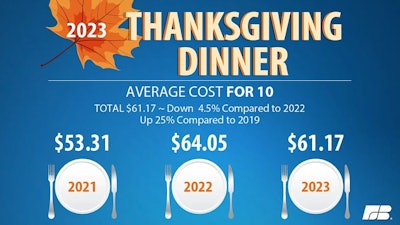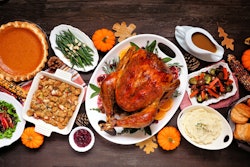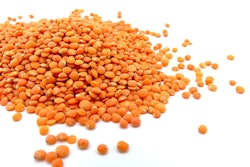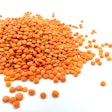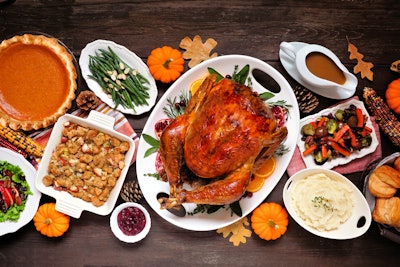
There's at least one thing Americans can be thankful for this Thanksgiving holiday -- the cost for this classic feast will be down slightly from last year's sticker shock. That being said, the meal still reflects historically high food costs.
In the American Farm Bureau Federation’s 38th annual Thanksgiving dinner survey, a meal for 10 will be $61.17, or $6.12 per guest, representing a 4.5% decline from last year's tab. Much of the decline is driven by a decline in the price of the Thanksgiving dinner centerpiece – the turkey. Despite the year-over-year relief, the cost is still 25% higher compared to 2019, prior to the COVID-19 pandemic.
What's on the Thanksgiving menu?
The AFBF marketbasket survey includes responses from all 50 states and Puerto Rico collected between November 1-6, mostly consisting of AFBF volunteer shoppers (members checking prices) visiting their local grocery stores to survey prices of the various items used to prepare a traditional Thanksgiving feast.
As part of the survey tradition dating back to 1986, volunteers collect price data on turkey, cubed stuffing, sweet potatoes, dinner rolls, frozen peas, fresh cranberries, celery, carrots, pumpkin pie mix, pie shells, whipping cream and whole milk.
To reflect an expanded Thanksgiving table, data on boneless ham, Russet potatoes and frozen green beans is also collected. When including the additional items, the cost of a Thanksgiving meal rose to $84.75 or $8.48 per person.
In the traditional basket, seven of the 11 surveyed items saw a price decrease since last year, including turkey, cubed stuffing, frozen peas, cranberries, pie shells, whipping cream and whole milk. The price of four items rose in price year-over-year – the relish tray (a mix of fresh celery and carrots), sweet potatoes, dinner rolls and pumpkin pie mix.
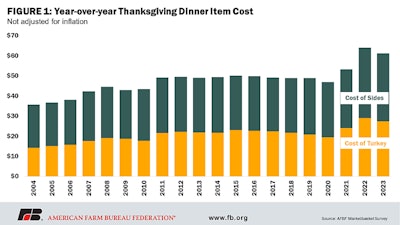
Thanksgiving's centerpiece -- the turkey
Over the past two decades, the turkey has accounted for an average of 43% of the price of the Thanksgiving dinner according to the AFBF survey, with a slight increase over time.
Over the past two decades, the turkey has accounted for an average of 43% of the price of the Thanksgiving dinner.
Cargill's Future of Turkey study noted a return in 2023 to traditional Thanksgiving celebrations, with more than eight in 10 consumers who responded saying they plan to purchase a whole turkey this year. This marks a turnaround from previous years when consumers often purchased individual turkey parts, such as turkey breasts, as they exercised caution during the pandemic with smaller gatherings and celebrations.
“Americans hold onto the belief that a whole turkey should be the centerpiece of a Thanksgiving meal with family and friends,” said Hans Kabat, president of Cargill’s North American protein business, who noted one out of every three Thanksgiving dinner tables this year will prominently feature a whole turkey.
In 2023, a 16-pound frozen whole turkey accounted for 45% of the traditional Thanksgiving basket at $27.35, a 5.6% decrease from 2022, noted the AFBF survey.
Given its prominence, the turkey is the true driver of Thanksgiving dinner prices. This year’s drop in turkey prices is attributable to a decrease in avian influenza cases and the resulting recovery in the turkey flock.
Turkey supplies and HPAI
The status of HPAI is much different now than it was just a year ago. According to AFBF, turkey supplies have recovered since the HPAI outbreak began. Due to the time it takes for poults placed on feed to be ready for market (about 14 weeks) poults must be placed on feed in July in order to be ready to market by Thanksgiving.
USDA’s September 2023 Livestock, Dairy, and Poultry Outlook noted the July 2023 turkey production was 432.3 million pounds. This is 9.7% above July 2022, but still about 6% below pre-2022 HPAI outbreak levels, with 457.9 million pounds produced in July 2021. Much of the increase in production is attributed to live weights (the weight of a market ready bird) rising 3.8% above last year and higher processing numbers.
Estimates are that more than 1.4 million poultry nationwide, including over 800,000 turkeys, have been lost due to the recent HPAI outbreak. WATTPoultry.com reported on November 9 that USDA's Animal and Plant Health Inspection Service confirmed a total of 254,700 turkeys were being depopulated in South Dakota and Minnesota due to the virus.
USDA’s annual Turkeys Raised report estimates that 219 million turkeys were raised in 2023, an increase of 4% from 2022 and 1% above pre-HPAI outbreak levels in 2021. This increase in the number of turkeys raised along with strong placements of poults on feed in May and June was a good indication of lower consumer prices ahead of Thanksgiving.
To learn more about HPAI cases in commercial poultry flocks in the U.S., Mexico and Canada, see an interactive map on WATTPoultry.com.
But what about the pie?
Of all items surveyed this year, pumpkin pie mix ($4.44 per 30 oz. can) and dinner rolls ($3.84 per dozen) had the largest percent increase at 3.8% and 3.0% respectively.
Interestingly, the AFBF July 4th Cookout survey similarly had hamburger buns with its largest annual price increase. Of products surveyed, dinner rolls are the most likely to be prepared in store and could be impacted by sustained increases in wages due to a tight labor market.
Products with the largest percentage drop in prices included whipping cream ($1.73 per half pint) and fresh cranberries ($2.10 per 12 oz.) at a decrease of 22.8% and 18.3% respectively. For cranberries, the price drop is indicative of expanded supply, as confirmed by production estimates from the Cranberry Marketing Committee (CMC) in August which indicate a 3.6% increase from the previous year to 8,165,000 100-lb barrel equivalents. Additionally, fresh cranberry import volumes are up 33% this year-to-date (January-September), almost exclusively from Canada. Of note, approximately 95% of U.S.-utilized cranberry production is processed.
Give thanks for affordable food
From a global viewpoint, despite food inflation and supply chain problems, food is more affordable in the U.S. than in other countries. In fact, the average U.S. consumer spends only 6.7% of their disposable income on food – the lowest of 104 countries measured by the USDA in 2022 and 20% lower than the next nearest country, Singapore at 8.4%.
Five countries have food expenditures that exceed 50% of disposable income, with the highest being Nigeria at 59%. The U.S. is lower than many peer nations as well, with Canadians and Australians all paying 10% of their disposable income on food.
Individual Prices
- 16-pound turkey: $27.35 or $1.71 per pound (down 5.6%)
- 14-ounces of cubed stuffing mix: $3.77 (down 2.8%)
- 2 frozen pie crusts: $3.50 (down 4.9%)
- Half pint of whipping cream: $1.73 (down 22.8%)
- 1 pound of frozen peas: $1.88 (down 1.1%)
- 1 dozen dinner rolls: $3.84 (up 2.9%)
- Misc. ingredients to prepare the meal: $3.95 (down 4.4%)
- 30-ounce can of pumpkin pie mix: $4.44 (up 3.7%)
- 1 gallon of whole milk: $3.74 (down 2.6%)
- 3 pounds of sweet potatoes: $3.97 (up .3%)
- 1-pound veggie tray (carrots & celery): $.90 (up 2.3%)
- 12-ounce bag of fresh cranberries: $2.10 (down 18.3%)
